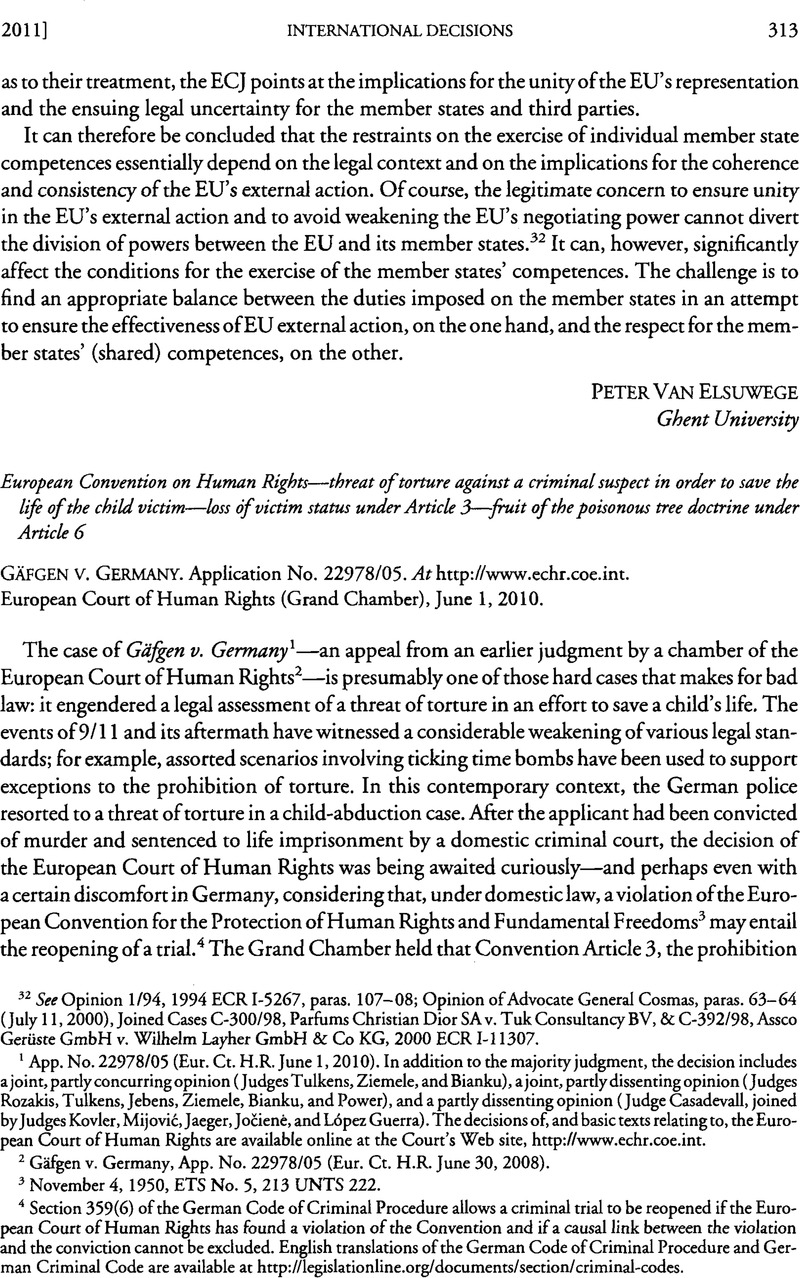Article contents
Gäfgen v. Germany
Published online by Cambridge University Press: 27 February 2017
Abstract

- Type
- International Decisions
- Information
- Copyright
- Copyright ©by the American Society of International Law,2011
References
1 App. No. 22978/05 (Eur. Ct. H.R. June 1,2010). In addition to the majority judgment, the decision includes a joint, partly concurring opinion (Judges Tulkens, Ziemele, and Bianku), a joint, partly dissenting opinion (Judges Rozakis, Tulkens, Jebens, Ziemele, Bianku, and Power), and a partly dissenting opinion (Judge Casadevall, joined by Judges Kovler, Mijović, Jaeger, Joĉiene, and López Guerra). The decisions of, and basic texts relating to, the European Court of Human Rights are available online at the Court’s Web site, http://vvrww.echr.coe.int.
2 Gäfgen v. Germany, App. No. 22978/05 (Eur. Ct. H.R. June 30, 2008).
3 November 4, 1950, ETS No. 5, 213 UNTS 222.
4 Section 359(6) of the German Code of Criminal Procedure allows a criminal trial to be reopened if the European Court of Human Rights has found a violation of the Convention and if a causal link between the violation and the conviction cannot be excluded. English translations of the German Code of Criminal Procedure and German Criminal Code are available at http://legislationline.org/documents/section/criminal-codes.
5 The applicant had also alleged that the officer repeatedly hit him in the chest, once shook his head so that it hit the wall, and threatened him with sexual abuse. These allegations could not be proven (paras. 96–98).
6 Grundgesetz Für Die Bundesrepublik Deutschland, May 23, 1949, BGBl. I at 1. An English translation of the Grundgesetz is available at http://legislationline.org/documents/section/constitutions/country/28.
7 Article 3 provides: “No one shall be subjected to torture or to inhuman or degrading treatment or punishment.”
8 Citing Chabalv. United Kingdom, 1996 Google Scholar -V Eur. Ct. H.R. 1831, para. 79, and Labita v. Italy, 2000-IV Eur. Ct. H.R. 99, para. 119.
9 The fines imposed—but then suspended—on the two police officers were sixty and ninety daily payments of €60 and €120, respectively, which the Grand Chamber qualified as “token fines” (para. 124). In terms of disciplinary measures, they were both removed from their posts, though the post to which the former deputy chief was later transferred (para. 125) essentially amounted, the applicant argued, to a promotion (para. 111).
10 According to the partly dissenting of Judge Casadevall (paras. 6–8), in which he was joined by five other judges, the applicant’s victim status did not depend on the severity of the penalties imposed on the police officers and the effectiveness of the official liability proceedings instituted by the applicant could not yet be assessed.
11 See Gäfgen v. Germany, App. No. 22978/05, paras. 100–09.
12 Citing, among other cases, Harutyunyan v. Armenia, 2007-VIII Eur. Ct. H.R., paras. 63, 66, and Levinta v. Moldova, App. No. 17332/03, paras. 100, 104 (Eur. Ct. H.R. Dec. 16, 2008).
13 Jalloh v. Germany, 2006-IX Eur. Ct. H.R., paras. 103–23. In this case, the administration of emetics was, in principle, in conformity with domestic law, but their use was considered excessive and disproportionate in view of the relatively minor crime actually involved.
14 See, e.g., Wayne R., Lafave, Jerold, Israel, & Nancy J., King, Criminal Procedure 502–08 (2000).Google Scholar
15 The Court has previously acknowledged that the investigation and prosecution of terrorist offenses presents the authorities with special problems. See Öcalan v. Turkey, 2005-IV Eur. Ct. H.R. 131, para. 104 (discussed in Mirja Trilsch & Alexandra Rüth, Case Report: Öcalan v. Turkey, 100 AJIL 180 (2006)).
16 Ever since 9/11, terrorist plots have commonly been used as the prime example of a scenario involving a ticking time bomb. See Alan M., Dershowitz, Is There a Torturous Road to Justice?, Los Angeles Times, Nov. 8, 2001, pt. 2, at 19.Google Scholar
17 See, e.g., Ireland v. United Kingdom, 25 Eur. Ct. H.R. (ser. A) at para. 167 (1978); Jacobs, White, & Ovey, The European Convention on Human Rights 170–72 (2010).
18 Section 211(1) of the German Criminal Code strictly provides for life imprisonment as the sentence for murder. Pursuant to section 57a( 1), however, conditional early release after fifteen years of the sentence have been served is excluded only if “the particular seriousness of the convicted person’s guilt [requires the sentence’s] continued enforcement.” In this context it is considered relevant whether the person has confessed or shown remorse.
- 1
- Cited by


